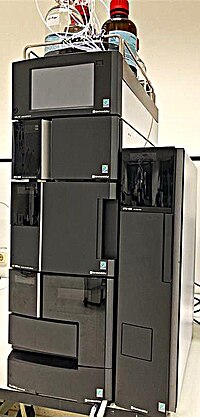High performance liquid chromatography

So, you know how sometimes you spill something on your shirt and you need to wash it out? Well, sometimes scientists need to separate different chemicals from a mixture, just like separating the spots in the shirt.
That's where High Performance Liquid Chromatography (HPLC) comes in. It's a fancy way of washing out the different chemicals in a mixture so that scientists can study them separately.
Here's how it works: Imagine you have a jar of colorful beads, each one a different size and color. You want to separate them by size and color. First, you pour the beads into a tube filled with a special liquid, kind of like soapy water.
Then, you take the tube and start shaking it up and down, really fast. This is where the "high performance" part comes in. The shaking helps the beads move through the liquid quickly, separating out by size and color.
But we still can't see the beads, they're too small! So, we need a special tool called a detector. The detector can see each bead as it comes out of the tube and sends a signal to a computer.
The computer can then make a chart, showing how many of each size and color bead there are. Scientists can use this chart to learn more about the chemicals in the mixture, just like how you can learn which colors and sizes of beads were in the jar.
Cool, huh?
That's where High Performance Liquid Chromatography (HPLC) comes in. It's a fancy way of washing out the different chemicals in a mixture so that scientists can study them separately.
Here's how it works: Imagine you have a jar of colorful beads, each one a different size and color. You want to separate them by size and color. First, you pour the beads into a tube filled with a special liquid, kind of like soapy water.
Then, you take the tube and start shaking it up and down, really fast. This is where the "high performance" part comes in. The shaking helps the beads move through the liquid quickly, separating out by size and color.
But we still can't see the beads, they're too small! So, we need a special tool called a detector. The detector can see each bead as it comes out of the tube and sends a signal to a computer.
The computer can then make a chart, showing how many of each size and color bead there are. Scientists can use this chart to learn more about the chemicals in the mixture, just like how you can learn which colors and sizes of beads were in the jar.
Cool, huh?
Related topics others have asked about:
